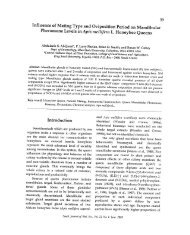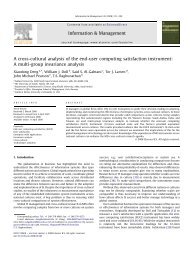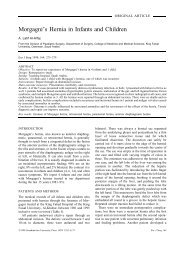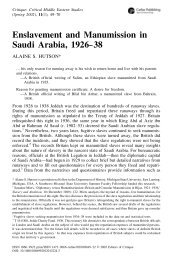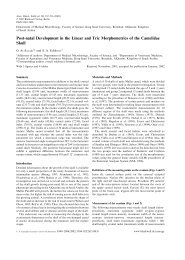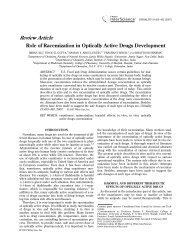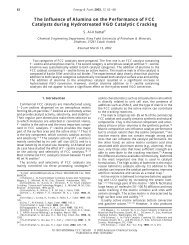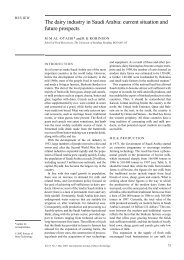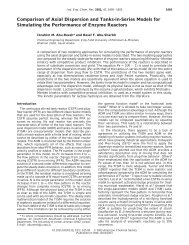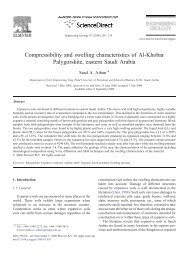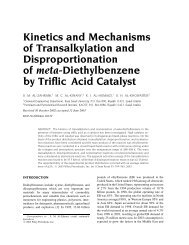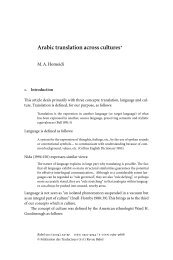(khamir) produced from sorghum in Gizan region, Saudi Arabia
(khamir) produced from sorghum in Gizan region, Saudi Arabia
(khamir) produced from sorghum in Gizan region, Saudi Arabia
Create successful ePaper yourself
Turn your PDF publications into a flip-book with our unique Google optimized e-Paper software.
222 M.A.A. GASSEM<br />
for improv<strong>in</strong>g <strong>khamir</strong> production, and to study the changes<br />
occurr<strong>in</strong>g <strong>in</strong> pH and titratable acidity which might have a<br />
major role <strong>in</strong> microbial distribution dur<strong>in</strong>g fermentation.<br />
MATERIALS AND METHODS<br />
Two local varieties of <strong>sorghum</strong> gra<strong>in</strong>s (Baydah and Hamra)<br />
were obta<strong>in</strong>ed <strong>from</strong> a gra<strong>in</strong> market <strong>in</strong> Abu-Arish (south-west<br />
<strong>Saudi</strong> <strong>Arabia</strong>). The <strong>sorghum</strong> was milled at the local gra<strong>in</strong><br />
market to f<strong>in</strong>e flour us<strong>in</strong>g a Diamant mill, model 500-mm<br />
(Denmark). The flour was then transferred to the laboratory<br />
<strong>in</strong> Riyadh and stored at 25 °C until used. Sorghum fermentation<br />
was carried out <strong>in</strong> the traditional way by mix<strong>in</strong>g<br />
<strong>sorghum</strong> flour with sterile deionized water and spices (onion,<br />
garlic, lemon juice and fenugreek) <strong>in</strong> a 1:0·8 (w/w) ratio to<br />
make a dough (traditionally called ‘ajeen’). The mixture was<br />
<strong>in</strong>cubated at 30 °C for 24 h <strong>in</strong> a sterile covered flask; usually,<br />
at this time, the dough will have a good consistency and sour<br />
taste. Two consecutive fermentations were carried out us<strong>in</strong>g<br />
3% <strong>in</strong>ocula (traditionally called ‘shetiah’) <strong>from</strong> the previous<br />
fermentation to start each subsequent batch. Each fermentation<br />
was performed <strong>in</strong> duplicate and sampled every 4 h<br />
for 24 h.<br />
Sampl<strong>in</strong>g<br />
At each sampl<strong>in</strong>g time, a 50 g sample was placed <strong>in</strong> a sterile<br />
stomacher bag and mixed with 450 ml sterile 0·1% peptone<br />
water (Oxoid) us<strong>in</strong>g a Stomacher Lab-Blender 400 (Seward<br />
Medical, London, UK). Appropriate serial dilutions <strong>in</strong> 0·1%<br />
peptone water were prepared and samples were plated on the<br />
different agar media.<br />
Microbiological analysis<br />
Total plate count was determ<strong>in</strong>ed on Plate Count Agar (PCA,<br />
Oxoid). The plates were <strong>in</strong>cubated at 32 °C for 24 h.<br />
Coliforms were enumerated on Violet Red Bile Agar<br />
(VRBA, Oxoid) and <strong>in</strong>cubated at 37 °C. Counts were taken<br />
at 24 and 48 h. Coliforms were isolated <strong>from</strong> VRBA plates,<br />
purified on PCA and identified us<strong>in</strong>g the API 20 system<br />
(BioMérieux, Marcy l’Etoile, France).<br />
Lactic acid bacteria were enumerated on de Man, Rogosa<br />
and Sharpe (MRS, Oxoid) agar. The plates were <strong>in</strong>cubated<br />
at 37 °C for 48 h under anaerobic conditions us<strong>in</strong>g GasPak<br />
(H 2 and CO 2) anaerobic systems (BBL Microbiology Systems,<br />
Cockeysville, MD, USA). Pure colonies <strong>from</strong> countable<br />
plates were Gram-sta<strong>in</strong>ed, ma<strong>in</strong>ta<strong>in</strong>ed <strong>in</strong> MRS broth,<br />
and fur-ther characterized us<strong>in</strong>g the API 50 CHL system<br />
(BioMérieux).<br />
Yeasts and moulds were enumerated on acidified potato<br />
dextrose agar (APDA, Oxoid). The plates were <strong>in</strong>cubated at<br />
25 °C for 3, 5 and 7 d. Isolated yeasts were purified on Sabou-<br />
raud medium (Difco) and characterized us<strong>in</strong>g the API AUX<br />
system (BioMérieux). Moulds were identified us<strong>in</strong>g 10 dayold<br />
cultures on potato dextrose agar (Oxoid). Cultural and<br />
microscopic characteristics were exam<strong>in</strong>ed and moulds were<br />
classified accord<strong>in</strong>g to Frazier and Westhoff (1988) and Barnett<br />
and Hunter (1972).<br />
Microbial identification<br />
Representatives <strong>from</strong> each colony type were selected <strong>from</strong><br />
plates used for viable counts at each sampl<strong>in</strong>g time accord<strong>in</strong>g<br />
to shape and/or colour. Isolates were purified by repeated<br />
streak<strong>in</strong>g on appropriate media and identified us<strong>in</strong>g appropriate<br />
identification systems.<br />
Measurement of pH and titratable acidity<br />
The pH of the fermented dough was measured us<strong>in</strong>g a pH<br />
meter (Jenway PHM10, Felsted, UK). Titratable acidity,<br />
expressed as percentage lactic acid, was determ<strong>in</strong>ed by<br />
titrat<strong>in</strong>g the samples with 0·1 mol l −1 NaOH to the phenolphthale<strong>in</strong><br />
end po<strong>in</strong>t.<br />
RESULTS<br />
Microbial counts<br />
Microbial counts of the <strong>in</strong>itial fermentation of <strong>sorghum</strong> (Bayadh<br />
variety) are presented <strong>in</strong> Fig. 1. The microflora of the<br />
naturally fermented <strong>sorghum</strong> flour consisted of different<br />
micro-organisms, such as lactic acid bacteria, coliforms,<br />
moulds and yeasts. Both the total bacteria and lactic acid<br />
bacteria counts <strong>in</strong>creased with <strong>in</strong>creas<strong>in</strong>g fermentation time<br />
until they reached stationary phase at 16 h (Fig. 1a). The yeast<br />
and mould counts rema<strong>in</strong>ed constant dur<strong>in</strong>g the fermentation.<br />
The coliform counts decreased until 12 h, then<br />
<strong>in</strong>creased, and thereafter decreased.<br />
When <strong>sorghum</strong> was fermented us<strong>in</strong>g an <strong>in</strong>oculum <strong>from</strong><br />
the previously fermented <strong>sorghum</strong>, the microbial counts also<br />
<strong>in</strong>creased with time. However, the total bacterial populations<br />
and lactic acid bacteria reached maximal growth <strong>in</strong> half the<br />
time of the <strong>in</strong>itial fermentation (Fig. 1c). No changes <strong>in</strong> mould<br />
and yeast counts were noticed dur<strong>in</strong>g fermentation. The coliforms<br />
decreased and were not detected after 12 h of fermentation.<br />
Data for the third fermentation (not shown) which was<br />
carried out us<strong>in</strong>g an <strong>in</strong>coulum <strong>from</strong> the previous fermentation<br />
were similar to those obta<strong>in</strong>ed for the second fermentation<br />
except for the coliforms, which were not detected after 8 h.<br />
For the Hamra variety, similar results were obta<strong>in</strong>ed for<br />
total bacterial counts, lactic acid bacteria, and yeasts and<br />
moulds <strong>in</strong> the <strong>in</strong>itial, second and third fermentations.<br />
However, for coliforms, <strong>in</strong>itial fermentation counts <strong>in</strong>creased<br />
© 1999 The Society for Applied Microbiology, Journal of Applied Microbiology 86, 221–225



